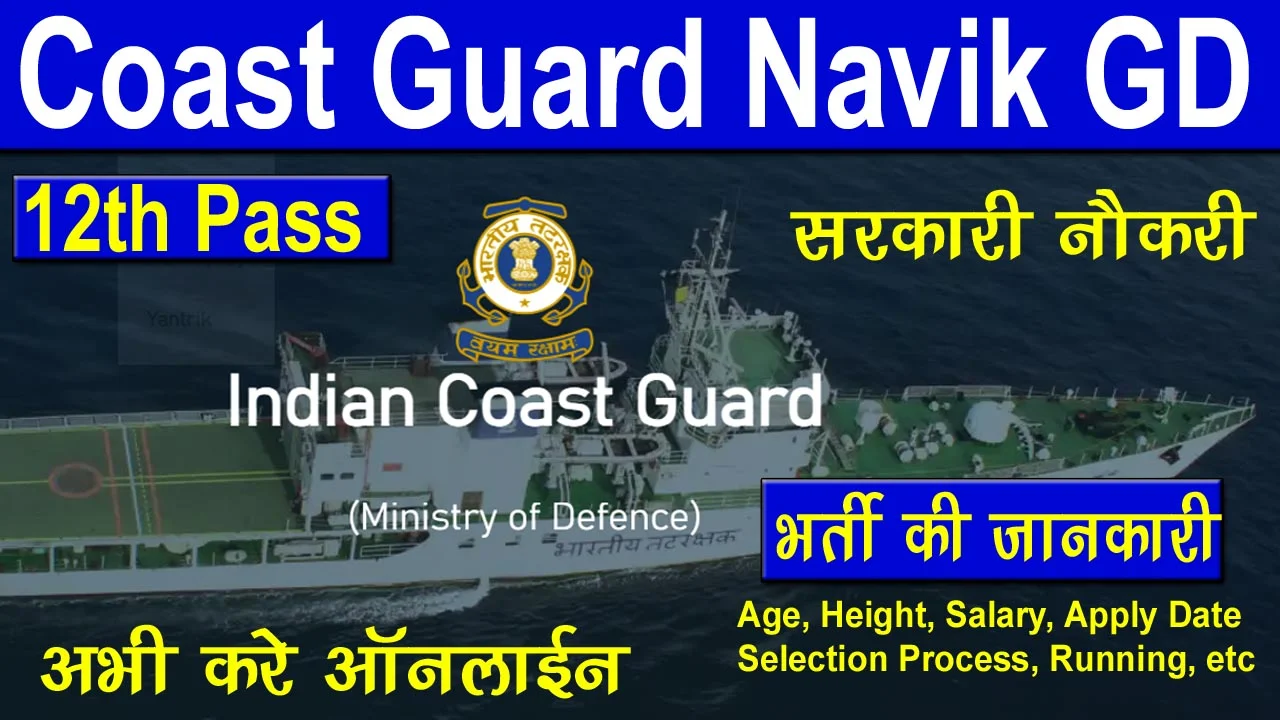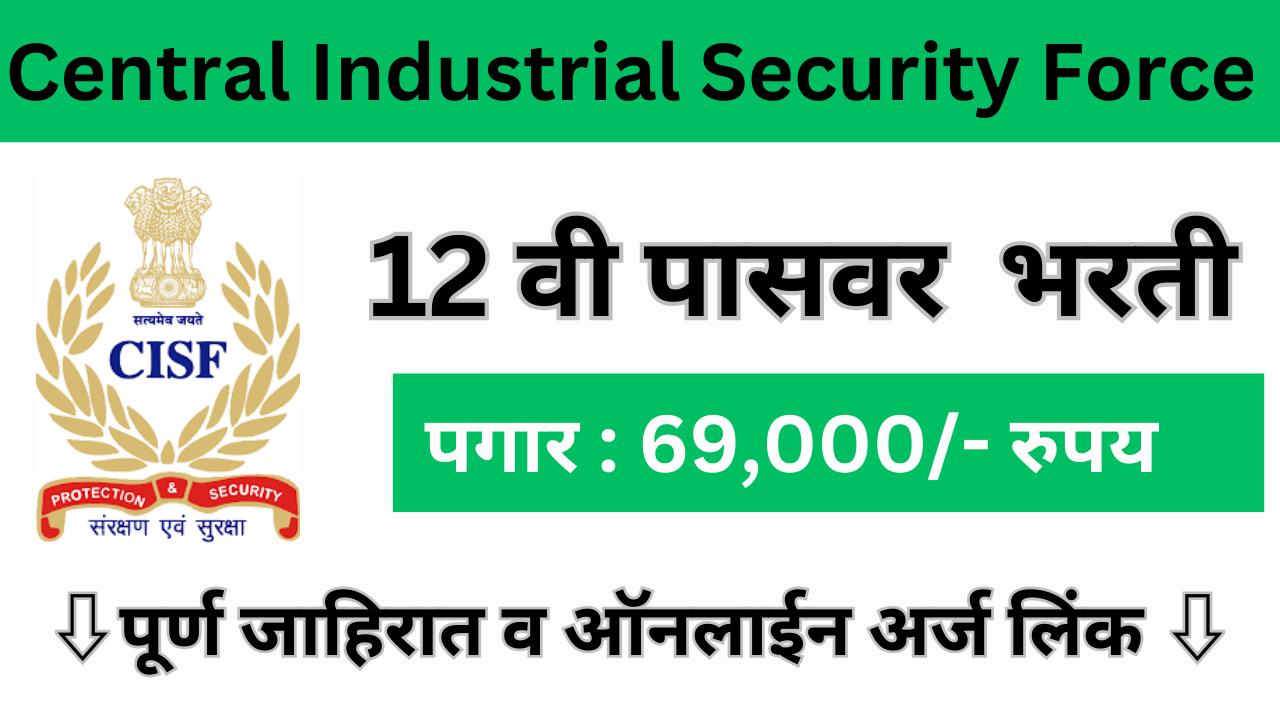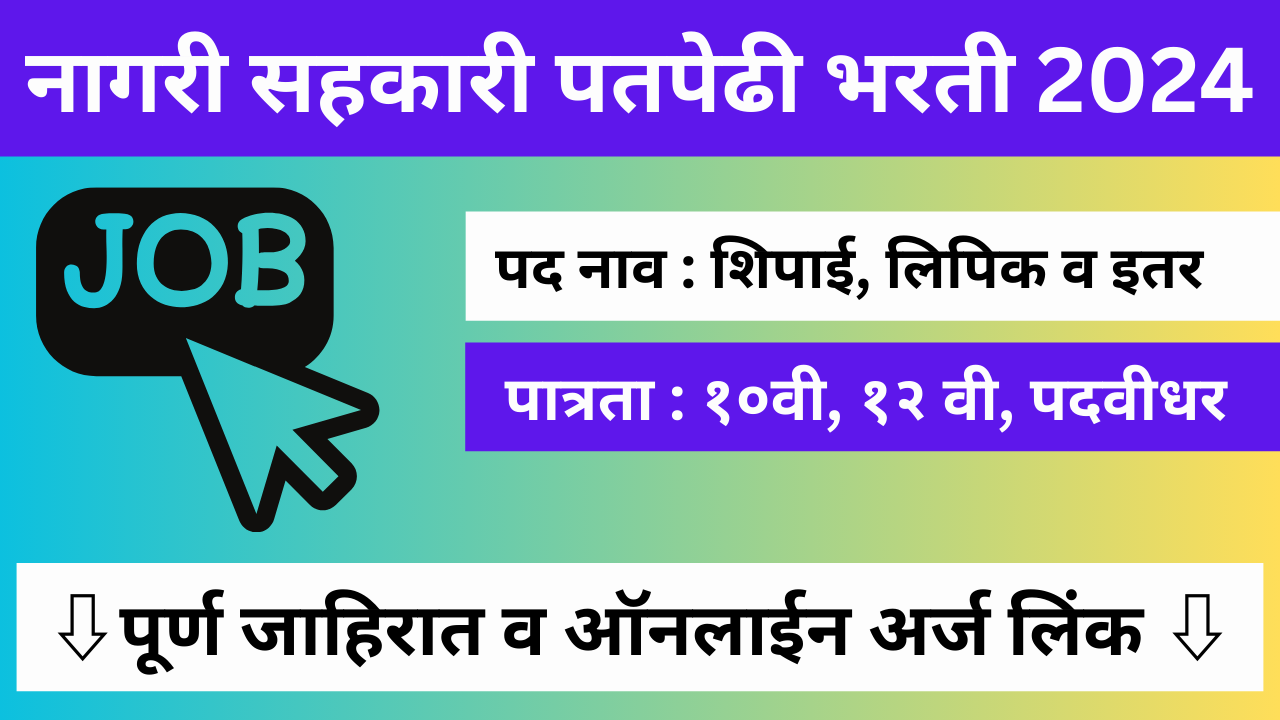Indian Coast Guard Bharti 2024 | भारतीय तटरक्षक दल में 330 जगा के लिए भरती
Indian Coast Guard Bharti 2024: Tatrakshak Dal Bharti, ICG Indian Coast Guard, Coast Guard Enrolled Personnel Test (CGEPT) & Assistant Commandant 260 नाविक (जीडी) और 70 सहायक कमांडेंट पदों के लिए भारतीय तटरक्षक भर्ती 2024 (भारतीय तटरक्षक भारती 2024)। भारतीय तटरक्षक बल भारत की समुद्री कानून प्रवर्तन और खोज और बचाव सेवा है, जिसके पास निकटवर्ती क्षेत्र और विशेष आर्थिक क्षेत्र सहित इसके क्षेत्रीय समुद्रों पर अधिकार है।
Indian Coast Guard Bharti 2024 Total Vacancy:
260 Post
Indian Coast Guard Bharti 2024 Post Name:
नाविक (जीडी) (जनरल ड्युटी-GD)
Indian Coast Guard Bharti 2024 Education Qualification:
12th Pass (Mathematics & Physics)
Indian Coast Guard Bharti 2024 Physical Qualification:
- Height: Minimum 157 cm.
- Chest: Minimum 5 cm.
Indian Coast Guard Bharti 2024 Age Limit:
जन्म 01 सितम्बर 2002 ते 30 अगस्त 2006 च्या दरम्यान।
- SC/ST: 05 वर्ष आयु की शूट
- OBC: 03 वर्ष आयु की शूट
Indian Coast Guard Bharti 2024 Job Location:
All India
Indian Coast Guard Bharti 2024 Fee:
General/OBC: Rs.300/-
SC/ST: No Fees
Online Application Start Date: February 13 2024
Online Application Last Date: 27 फेब्रुवारी 2024 (05:30 PM)
Indian Coast Guard Bharti 2024 Exam Date:
| स्टेज-I | स्टेज-II | स्टेज-III & IV |
| एप्रिल 2024 | मे 2024 | ऑक्टोबर 2024 |
Indian Coast Guard Bharti 2024 How To Apply:
Online Application: Apply Online
Also Read: Indian Army Agniveer Bharti 2024: भारतीय सैन्य अग्निवीर भरती
Indian Coast Guard Bharti 2024 Syllabus Stage-I
Stage-I has a Computer Based Examination for the candidates to check their ability and knowledge in different subjects. The subjects that it includes are general knowledge, reasoning, aptitude, English, and concerning technical subjects (Mechanical/ Electrical/ Electronics & Telecommunications). It will have objective type questions only. Go through the subject wise IGC Yantrik syllabus mentioned below:
Science
- Nature of Matter, Universe (Planets / Earth/Satellites/Sun), Electricity and its application
- Force and Gravitation
- Newton’s Laws Of Motion
- Work, Energy and Power
- Heat
- Temperature
- Metals and Non-Metals
- Carbon and its Compounds
- Measurements in Science
- Sound & Wave Motion
- Atomic Structure
Mathematics
- Mathematical Simplification
- Ratio and Proportion
- Algebric Identities
- Linear Equations and Polynomials
- Simultaneous Equations
- Basic Trigonometry
- Simple Mensuration
- Geometry
- Measures of Central Tendency (Average, Median and Mode)
- Interest
- Profit, Loss and Percentage
- Work, Time, Speed and Distance
English
- Passage
- Preposition
- Correction of sentences
- Change Active to Passive and Passive to Active Voice
- Change direct to indirect/indirect to direct
- Verbs/Tense Non Finites
- Punctuation
- Substituting phrasal verbs for expression
- Synonyms and Antonyms
- Meanings of difficult words
- Use of adjectives
- Compound preposition.
- Use of pronouns
General Awareness
- Geography: Soil, Rivers, Mountains, Ports, Inland, Harbours
- Culture and Religion, Freedom Movement, Important National Facts about India, Heritage, Arts and Dance
- History, Defence
- Wars and neighbours
- Awards
- Authors
- Discoveries
- Diseases and Nutrition
- Current Affairs
- Languages
- Capitals and Currencies
- Common Names
- Full Forms and Abbreviations
- Eminent Personalities
- National Bird/Animal/Sport/Flower/Anthem/ Song/ Flag/Mountains
- Sports: Championships / Winners /Terms / Number of Players
Reasoning
- Spatial, Numerical Reasoning & Associative Ability
- Sequences
- Spellings Unscrambling
- Coding and Decoding
Electrical Diploma Engineering
Basic concepts
Concepts of resistance, inductance, Capacitance and Various Factors affecting them. Concepts of current, voltage, power, energy and their units.
Circuit law
Kirchhoff‘s law, Simple Circuit solution using network theorems.
Magnetic Circuit
Concepts of flux, EMF, reluctance, Different kinds of magnetic materials, Magnetic calculations for conductors of different configuration e.g. straight, circular, solenoidal, etc. Electromagnetic induction, self and mutual induction.
AC Fundamentals
Instantaneous, peak, R.M.S. and average values of alternating waves, Representation of sinusoidal wave form, simple series and parallel AC Circuits consisting of R.L. and C, Resonance, Tank Circuit. Poly Phase system – star and delta connection, 3 phase power, DC and sinusoidal response of R-Land R-C circuit.
Measurement and measuring instruments
Measurement of power (1 phase and 3 phase, both active and re-active) and energy, 2 wattmeter method of 3 phase power measurement. Measurement of frequency and phase angle. Ammeter and voltmeter (both moving oil and moving iron type), an extension of range wattmeter, Multimeters, Megger, Energy meter AC Bridges. Use of CRO, Signal Generator, CT, PT and their uses. Earth Fault detection.
Electrical Machines
(a) D.C. Machine – Construction, Basic Principles of D.C. motors generators and their characteristics, speed control and starting of D.C. Motors. Method of braking motor, Losses and efficiency of D.C. Machines.
(b) 1 phase and 3 phase transformers – Construction, Principles of operation, equivalent circuit, voltage regulation, O.C. and S.C. Tests, Losses and efficiency. Effect of voltage, frequency and waveform on losses. Parallel operation of 1 phase /3 phase transformers. Autotransformers.
(c) 3 phase induction motors, rotating magnetic field, the principle of operation, equivalent circuit, torque-speed characteristics, starting and speed control of 3 phase induction motors. Methods of braking, the effect of voltage and frequency variation on torque-speed characteristics, Fractional Kilowatt Motors and Single Phase Induction Motors: Characteristics and applications.
Synchronous Machines
Generation of 3-phase e.m.f. armature reaction, voltage regulation, parallel operation of two alternators, synchronizing, control of active and reactive power. Starting and applications of synchronous motors.
Generation, Transmission and Distribution
Different types of power stations, Load factor, diversity factor, demand factor, cost of generation, inter-connection of power stations. Power factor improvement, various types of tariffs, types of faults, short circuit current for symmetrical faults.
Switchgears and Protection
Rating of circuit breakers, Principles of arc extinction by oil and air, H.R.C. Fuses, Protection against earth leakage / over current, etc. Buchholz relay, Merz-Price system of protection of generators & transformers, protection of feeders and bus bars. Lightning arresters, various transmission and distribution system, comparison of conductor materials, the efficiency of different systems. Cable – Different types of cables, cable rating and derating factors.
Estimation And Costing
Estimation of lighting scheme, electric installation of machines and relevant IE rules. Earthing practices and IE Rules.
Utilization of Electrical Energy
Illumination, Electric heating, Electric welding, Electroplating, Electric drives and motors.
Basic Electronics
Working of various electronic devices e.g. PN Junction diodes, Transistors (NPN and PNP type), BJT and JFET. Simple circuits using these devices.
Electronics Diploma Engineering
Basic concepts
Concepts of resistance, inductance, capacitance, and various factors affecting them. Concepts of current, voltage, power, energy and their units.
Electronic Components & Materials
Conductors, Semi conductor& Insulators; Magnetic materials; Jointing & Cleaning materials for U/G copper cable & OFC; Cells and Batteries (chargeable and non chargeable); Relays, Switches, MCB & Connectors.
Electronic Devices and Circuits
PN Junction diodes, thyristor; Diode and triode circuits; Junction Transistors; Amplifiers; Oscillator; Multivibrator, counters; Rectifiers; Inverter and UPS.
Digital Electronics
Number System & Binary codes; Boolean Algebra & Logic gates; Combinational & Sequential logic circuits; A/D & D/A converter, counters; Memories.
Linear Integrated Circuit
Introduction to operational Amplifier; Linear applications; Non Linear applications; Voltage regulators; Timers; Phase lock loop.
Microprocessor and Microcontroller
Introduction to microprocessor, 8085 microprocessor working; Assembly Language programming; Peripherals & other microprocessors; Microcontrollers.
Electronic Measurements
Measuring systems; Basic principles of measurement; Range Extension methods; Cathode ray oscilloscope, LCD, LED panel; Transducers.
Communication Engineering
Introduction to communication; Modulation techniques; Multiplexing Techniques; Wave Propagation, Transmission line characteristics, OFC; Fundamentals of Public Address systems, Electronic exchange, Radar, Cellular and Satellite Communication.
Data communication and Network
Introduction to data communication; Hardware and interface; Introduction to Networks and Networking devices; Local Area Network and Wide area network; Internet working.
Computer Programming
Programming concepts; Fundamentals of ‘C’ and C ++; Operators in ‘C’ and C ++; Control Statements; Functions, Array String & Pointers, File Structure; Data Structure and DBMS.
Basic Electrical Engineering
DC Circuits; AC fundamentals; Magnetic, Thermal and Chemical effects of Electric current; Earthing – Installation, Maintenance, Testing.
Mechanical Engineering Diploma
Engineering Mechanics
Resolution of forces, Equilibrium and Equilibrant, parallelogram law of forces, triangle law of forces, polygon law of forces and Lami’s theorem, couple and moment of a couple, condition for equilibrium of rigid body subjected to number of coplanar non-concurrent forces, definition of static friction, dynamic friction, derivation of limiting angle of friction and angle of repose, resolution of forces considering friction when a body moves on horizontal plane and inclined plane, calculation of moment of inertia and radius of gyration of : (a) I-Section (b) channel section (c) T-Section (d) L-Section (Equal & unequal lengths) (e) Z-Section (f) Built up sections (simple cases only), Newton’s laws of motion (without derivation), motion of projectile, D’Alembert’s principle, definition law of conservation of energy, law of conservation of momentum.
Material Science
Mechanical properties of engineering materials – tensile strength, compressive strength, ductility, malleability, hardness, toughness, brittleness, impact strength, fatigue, creep resistance. Classification of steels, mild steel and alloy steels. Importance of heat treatment. Heat treatment processes – annealing, normalizing, hardening, tempering, carburizing, nitriding and cyaniding
Strength of Materials
Stress, strain, stress strain diagram, factor of safety, thermal stresses, strain energy, proof resilience and modules of resilience. Shear force and bending moment diagram – cant leaver beam, simply supported beam, continuous beam, fixed beam. Torsion in shafts and springs, thin cylinder shells.
Machining
Working principle of lathe. Types of lathes – Engine lathe – construction details and specifications. Nomenclature of single point cutting tool, geometry, tool signature, functions of tool angles. General and special operations – (Turning, facing, taper turning thread cutting, knurling, forming, drilling, boring, reaming, key way cutting), cutting fluids, coolants and lubricants. Introduction to shaper, slotter, plainer, broaching, milling and manufacture of gears, heat treatment process applied to gears.
Welding
Welding – Introduction, classification of welding processes, advantages and limitations of welding, principles of arc welding, arc welding equipment, choice of electrodes for different metals, principle of gas (oxy-acetylene) welding, equipment of gas welding, welding procedures (arc & gas), soldering and brazing techniques, types and applications of solders and fluxes, various flame cutting processes, advantages and limitations of flame cutting, defects in welding, testing and inspection modern welding methods, (submerged, CO2, atomic – hydrogen, ultrasonic welding), brief description of MIG & TIG welding.
Grinding & Finishing Process
Principles of metal removal by grinding, abrasives, vitrified, silicate, shellac rubber, grinding machines, natural and artificial, bonds and binding processes,, classification: cylindrical, surface, tool & cutter grinding machine, construction details, relative merits, principles of centreless grinding, advantages & limitations of centreless grinding work, holding devices, wheel maintenance, balancing of wheels, coolants used, finishing by grinding, honing, lapping, super finishing, electroplating, basic principles – plating metals, applications, hot dipping, galvanizing tin coating, parkerising, anodizing, metal spraying, wire process, powder process and applications, organic coatings, oil base paint, lacquer base enamels, bituminous paints, rubber base coating.
Metrology-
Linear measurement – Slip gauges and dial indicators, angle measurements, bevel protractor, sine bar, angle slip gauges, comparators (a) mechanical (b) electrical (c) optical (d) pneumatic. Measurement of surface roughness; methods of measurements by comparison, tracer instruments and by interferometry, collimators, measuring microscope, interferometer, inspection of machine parts using the concepts of shadow projection and profile projection.
Fluid Mechanics & Hydraulic Machinery
Properties of fluid, density, specific weight, specific gravity, viscosity, surface tension, compressibility capillarity, Pascal’s law, measurement of pressures, concept of buoyancy. Concept of Reynold’s number, pressure, potential and kinetic energy of liquids, total energy, laws of conservation, mass, energy and momentum, velocity of liquids and discharge, Bernoulli’s equation and assumptions, venturimeters, pitottube, current meters. Working principle & constructional details of centrifugal pump, efficiencies – manometric efficiency, volumetric efficiency, mechanical efficiency and overall efficiency, cavitation and its effect, working principle of jet & submersible pumps with line diagrams.
Industrial Management
Job analysis, motivation, different theories, satisfaction, performance reward systems, production, planning and control, relation with other departments, routing, scheduling, dispatching, PERT and CPM, simple problems. Materials in industry, inventory control model, ABC Analysis, Safety stock, re-order, level, economic ordering quantity, break even analysis, stores layout, stores equipment, stores records, purchasing procedures, purchase records, Bin card, Cardex, Material handling, Manual lifting, hoist, cranes, conveyors, trucks, fork trucks.
Thermal Engineering
Laws of thermo dynamics, conversion of heat into work vice versa , laws of perfect gases, thermo dynamic processes – isochoric, isobaric, isothermal hyperbolic, isentropic, polytrophic and throttling, modes of heat transfer, thermal conductivity, convective heat transfer coefficient, Stefan Boltzman law by radiation and overall heat transfer coefficient. Air standards cycles – Carnot cycle, Otto cycle, Diesel cycle, construction and working of internal combustion engines, comparison of diesel engine and petrol engine. Systems of internal combustion engine, performance of internal combustion engines. Air compressors their cycles refrigeration cycles, principle of a refrigeration plant
Indian Coast Guard Bharti 2024 Syllabus Stage-II
The Stage-II is a Physical Fitness Test. The candidates who successfully qualify the written examination will go through this stage. Sportswear is compulsory for this test like Sport Shoe, T-Shirt, Trouser, etc. To qualify this round, candidates will have to perform the following exercises:
- 1.6 Km run to be completed in 7 minutes.
- 20 squat ups (Uthak Baithak).
- 10 Push-ups.
NOTE
- Candidates will go through the PFT on their own risk. The founding authority will not be responsible.
- The candidates who are physically challenged cannot apply for this post.
- Candidates who qualify for the physical fitness test will undergo a medical examination. Candidates who complete the medical procedure will be selected for the post.
Medical Standards
Medical examination will be conducted by authorized military doctors as per medical standard prescribed in current regulations applicable to Enrolled Personnel on entry.
- Height: Minimum height 157 cms.
- Chest: Well proportioned and should be minimum expansion 5 cms.
- Weight: Proportionate to height and age +10% acceptable.
- Hearing: Normal
- Fitness Level: No Cardio-vascular disease, surgical deformities like knock knee, flat feet, etc. infection of ears, no history of fits or psychiatric ailment, varicose vein, undergone corrective surgery for eyesight, etc are not eligible.
- Visual Standards: 6/24 without glasses and 6/9 & 6/12 with glasses for Better Eye and Worse Eye respectively.
- Tattoos: No permanent tattoos are allowed.
Indian Coast Guard Bharti Exam Pattern 2024
The selection procedure will include two stages which are the written examination and physical fitness test. The candidates who have qualified the written examination will be called for the physical fitness test at their nearest examination center. The exam pattern for both the stages is given below:
| Post | Sections Involved | Passing Marks | Remarks |
| Yantrik (Electrical) | Section (I+III) | 30+20= 50 (UR/ EWS/ OBC) 27+17= 44 (SC/ST) | Passing in section I and III separately is compulsory |
| Yantrik (Electronics) | Section (I+IV) | 30+20= 50 (UR/ EWS/ OBC) 27+17= 44 (SC/ST) | Passing in section I and IV separately is compulsory |
| Yantrik (Mechanical) | Section (I+V) | 30+20= 50 (UR/ EWS/ OBC) 27+17= 44 (SC/ST) | Passing in section I and V separately is compulsory |
The details of the above-mentioned sections are as follows:
| Name of Exam | Details | Subjectwise allocation | Passing Marks | Syllabus |
| Section 1 | Maximum Marks – 60 Time – 45 mins. Total no. of Questions – 60 | Maths – 20 Science – 10 English – 15 Reasoning–10 GK – 5 | 30 (UR/EWS/ OBC category) 27 (for SC/ST category) | Class 10th Syllabus |
| Section 2 | Maximum Marks – 50 Time – 30 mins. Total no. of Questions – 50 | Maths – 25 Physics– 25 | 20 (UR/EWS/ OBC category) 17 (for SC/ST category) | Class 12thMaths& Physics Syllabus |
| Section 3 | Maximum Marks – 50 Time – 30 mins. Total no. of Questions – 50 | Electrical Engineering – 50 | 20 (UR/EWS/ OBC category) 17 (for SC/ST category) | Diploma Level Electrical Engineering syllabus |
| Section 4 | Maximum Marks – 50 Time – 30 mins. Total no. of Questions – 50 | Electronics Engineering – 50 | 20 (UR/EWS/ OBC category) 17 (for SC/ST category) | Diploma Level Electronics Engineering syllabus |
| Section 5 | Maximum Marks – 50 Time – 30 mins. Total no. of Questions – 50 | Mechanical Engineering – 50 | 20 (UR/EWS/ OBC category) 17 (for SC/ST category) | Diploma Level Mechanical Engineering syllabus |



